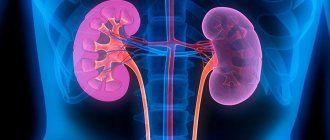Pus in the urine or pyuria is a condition that occurs when there is an excess of white blood cells or manure in the urine. Doctors detect a high count, at least 10 white blood cells per cubic millimeter (mm³), of centrifugal urine. Pyuria is characterized by cloudy urine and often indicates the presence of a urinary tract infection. In addition to pyuria, there may also be sterile pyuria - urine that contains white blood cells but still appears free of bacteria and microorganisms, based on urine testing methods.
Along with pus in the urine, symptoms may include: frequent urge to urinate, burning sensation when urinating, blood in the urine, foul-smelling urine, pelvic pain, fever, abdominal pain, abnormal discharge, shortness of breath, nausea or vomiting.
Causes
Pyuria can occur due to many diseases. It is most often caused by an infection in any area of the urinary system, including the kidneys, ureters, urethra, or bladder. Sterile pyuria is most often caused by sexually transmitted infections such as gonorrhea or viral infections.
Other causes of pus in the urine include: interstitial cystitis, bacteria from sepsis, tuberculosis, urinary tract stones, liver disease, pneumonia, autoimmune diseases, parasites, urinary tract tumors, polycystic kidney disease.
Pyuria can also be a reaction to certain medications:
- non-steroidal anti-inflammatory drugs;
- diuretics;
- penicillin antibiotics;
- proton pump inhibitors.
Also, the reasons for the appearance of pus in the urine may be:
Pregnancy
Pyuria often occurs during pregnancy. This is due to anatomical and hormonal changes during this period, which allows bacteria to enter the urinary tract. Infection or even asymptomatic presence of bacteria in the urine during pregnancy can be harmful and cause complications in the baby.
Dehydration
Cloudy urine, especially if it is dark, may indicate that a person is not drinking enough fluids.
Children or older people are at higher risk of dehydration. Anyone who has an illness that causes diarrhea, vomiting or fever needs to drink more fluids. Those who exercise or do manual labor on hot days may also have a higher risk of dehydration. Severe dehydration can lead to severe symptoms, including confusion, loss of consciousness, or bloody or black stool.
Kidney infection
Many kidney infections start out as STIs, which then spread due to lack of effective treatment and get worse over time. Kidney infections require immediate medical treatment. Without prompt treatment, this type of infection can lead to permanent kidney damage.
Sexually transmitted infection
Some common STIs, such as gonorrhea and chlamydia, can cause cloudy urine. Gonorrhea and chlamydia cause the immune system to fight off and produce white blood cells, which can mix with the urine and give it a cloudy appearance.
Vulvovaginitis
Vulvovaginitis is inflammation of the vulva and vagina, which can lead to cloudy urine. Bacterial infections are the most common cause of vulvovaginitis, although infections can also result from viruses or fungi. In some cases, the body may react to ingredients in soaps, detergents, fabric softeners, or other products.
Prostatitis
An inflamed prostate, or prostatitis, can also cause cloudy urine.
Diseases
When pus appears in the urine, a person understands that pyuria can be caused by various diseases of the liver, kidneys, ureters, bladder and urethra.
Infections that are sexually transmitted can cause cloudy urine. For example, gonorrhea or chlamydia. Also, the causes of pus in the urine in women are vulvovaginitis, cystitis, and in men - prostatitis.
Kidney infections, the presence of stones in the urinary tract, tuberculosis of the urinary system, and oncology also lead to the appearance of pus in the urine and require immediate treatment.
Diagnostics
Your doctor will do a urine test to diagnose pyuria. This involves taking a urine sample, which is then analyzed based on its appearance, concentration and content.
Urinalysis may also highlight other abnormalities. For example, the presence of nitrite or leukocyte esterase may indicate a urinary tract infection, while elevated protein levels may indicate kidney disease. During the diagnostic process, it is important that other secretions do not contaminate the urine sample. This is especially important for women because vaginal discharge contains bacteria that can confuse test results.
Additional diagnostic testing may be needed to determine the cause of pyuria. This may be an intravenous pyelogram, computed tomography, magnetic resonance imaging, or abdominal ultrasound.
Paracystitis
Making a diagnosis is not difficult if you have a typical clinical picture and a history of inflammatory diseases of the urinary tract. Difficulties arise in the case of a chronic course with minor symptoms. An inflammatory process in the peri-vesical tissue should be suspected when swelling or local tenderness is detected in the suprapubic region. The patient examination plan includes methods such as:
- Cystoscopy
. With transurethral insertion of a flexible endoscope, it is possible to visualize the bladder cavity. Paracystitis is characterized by depression into the lumen of one of the walls, bullous edema and hyperemia of the mucous membrane in the area of the abscess. Sometimes cystoscopy reveals a fistulous tract through which the contents of the abscess are released. - X-ray
. Cystography can reveal deformation and compression of the bladder, a decrease in its volume. There is a pronounced limitation in the mobility of the urovesical wall involved in the inflammatory process. Sometimes, during the formation of fistulas, contrast material leaks into the paravesical fatty tissue. - Echography
. With purulent paracystitis, during ultrasound of the bladder, the abscess is visible as a zone of reduced echogenicity with individual hyperechoic inclusions. In a chronic process, signs of sclerosis and fibrosis are determined. Transvaginal sonography is recommended for women to increase the accuracy of the method.
A clinical blood test for paracystitis reveals nonspecific changes characteristic of the inflammatory process - leukocytosis with an increase in the number of band neutrophils, an increase in ESR. In a general urine test, pyuria or microhematuria may appear after opening an abscess into the bladder. The patient is prescribed a vaginal or rectal examination, during which an infiltrate or fluctuation in the retrovesical tissue is detected. In addition to observation by a urologist, consultations with a gynecologist, proctologist, oncologist, and surgeon are recommended.
Differential diagnosis of paracystitis is carried out with acute and chronic cystitis, interstitial cystitis, bladder tumors, pelvioperitonitis, in women - with parametritis, subserous myoma and other uterine tumors, adnexitis, abscess of the pouch of Douglas. In case of phlegmonous course, it is necessary to exclude acute appendicitis, intestinal obstruction, acute prostatitis, and purulent adnexitis. Anterovesical paracystitis is sometimes differentiated from symphysitis, osteomyelitis and periostitis of the pubic bones.
Which doctor should I contact?
If you notice that your urine has become cloudy and has an unpleasant odor, first contact your family doctor, who, based on test results and a physical examination, will be able to refer you to a specialist. Depending on the cause, this may be a urologist, gynecologist, infectious disease specialist, or cardiologist.
Most cases of pyuria do not pose a serious health risk, but anyone who experiences pus in their urine should see a doctor who can help determine the underlying cause.
Treatment and what to do
First of all, you should immediately contact a nephrologist or urologist; everyone knows that prevention is always much better and simpler, but since the pathology has already developed, you cannot wait.
Standard pathogenetic treatment is aimed at destroying the infectious agent, that is, in order to remove the harmful effects of bacteria on the body, antibiotic therapy is carried out after determining the sensitivity of these microorganisms using an antibiogram (it is usually carried out from 7 to 14 days, until the symptoms stop, and another 3 days after this).
In parallel with this, symptomatic treatment (relief of pain, dysuria, and other manifestations). In case of a severe acute process, bed rest is observed, it is advisable to lie with the upper half of the body elevated, and not wait to go to the toilet, because stagnation of urine will prevent a speedy recovery.
It is important to maintain a minimum suppressive dose of antibiotics (the minimum dose at which 100% of microorganisms are guaranteed to die), and not to stop taking the medications yourself as you feel better. This is fraught with consequences - the disease can become chronic, and bacteria can develop resistance to antibiotics.
A diet is also recommended - less salty, spicy, more liquid, to more effectively remove bacterial breakdown products and reduce intoxication. It is possible to prescribe immunomodulators (to correct weakened immunity) and vitamins.
Prevention
Practicing good personal hygiene can help prevent urinary tract infections. This includes always wiping from front to back, after urination and bowel movements, as well as daily washing of the skin around the vagina and rectum. Washing or showering, both before and after sexual activity, can also reduce the risk of urinary tract infection. You can use the following prevention methods:
- do not use scented intimate hygiene products
- avoid tight clothing and synthetic underwear;
- drink enough fluids throughout the day;
- reduce the amount of caffeine you consume;
- use condoms during sexual intercourse.
What does pus look like in urine?
In medical language, this pathology is called pyuria . However, the diagnosis can only be confirmed by analysis. If pus is present, the analysis will show a large number of leukocytes in the urine. If their number per unit volume of liquid is more than three million, we can talk about pyuria.
In this case, the urine becomes cloudy, formations in the form of flakes and threads are noticeable. In order to exclude false results, women undergo urine collection through a catheter, men - after preliminary disinfection of the head of the genital organ.
Along with leukocytes, a number of bacteria are found : staphylococci, Escherichia coli, Klebsiella. Sexually transmitted organisms can also be detected: chlamydia, ureaplasma, mycoplasma, trichomonas. They provoke inflammation in the urethra. To identify them, a smear is taken from the vagina.
Pyuria is not an independent pathology. It signals urinary tract infections or pathologies of internal organs. However, a general urine test does not provide information about the nature of the appearance of pus. To determine the form of pyuria, special tests are used.
There are four forms of pyuria :
- terminal - possible with prostatitis,
- aseptic,
- total - indicates damage to the upper parts of the urinary system,
- initial - with inflammation of the urinary tract in the lower sections or urethra.
In this case, there are no pathogenic microorganisms in the urine. This is possible with dehydration in children, with a disease such as kidney tuberculosis, and with poisoning.
With a 3-glass test, leukocytes can be detected in the first portion of urine, then the initial form is diagnosed.
When they are present in the last, third stage, this is a terminal form, which indicates a deeper focus of inflammation. If leukocytes exceed the norm in both the middle and last portions, this may indicate a complete (total) form of pathology.







